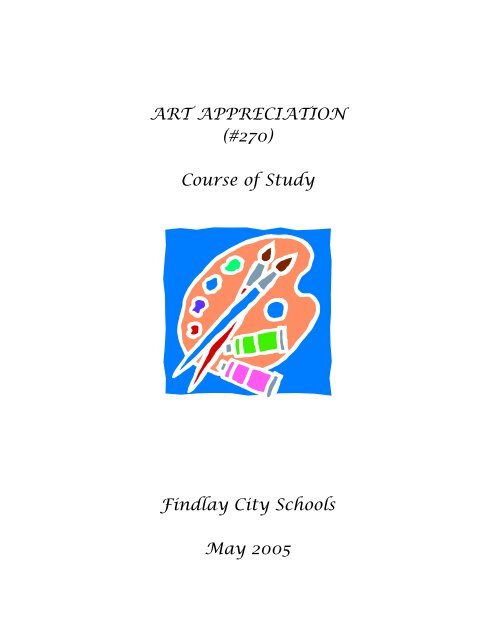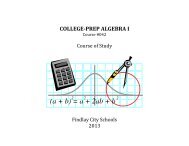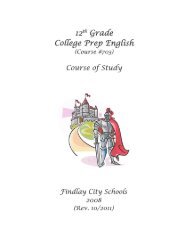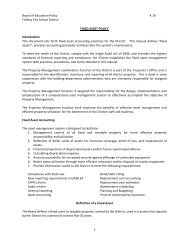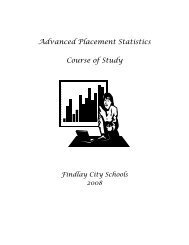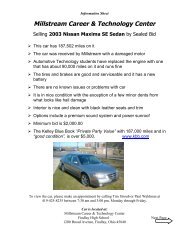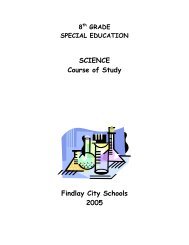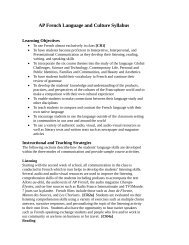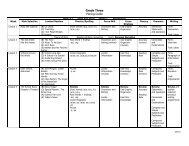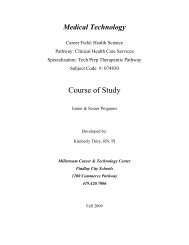Art Appreciation - Findlay City Schools
Art Appreciation - Findlay City Schools
Art Appreciation - Findlay City Schools
Create successful ePaper yourself
Turn your PDF publications into a flip-book with our unique Google optimized e-Paper software.
ART APPRECIATION<br />
(#270)<br />
Course of Study<br />
<strong>Findlay</strong> <strong>City</strong> <strong>Schools</strong><br />
May 2005
TABLE OF CONTENTS<br />
1. <strong>Findlay</strong> <strong>City</strong> <strong>Schools</strong>’ Board Policy<br />
2. <strong>Findlay</strong> <strong>City</strong> <strong>Schools</strong>’ Mission Statement and Beliefs<br />
3. Curriculum Map<br />
4. Benchmarks and Indicators<br />
<br />
Curriculum Writing Team<br />
NANCY FRANKENFIELD
Mission Statement<br />
The mission of the <strong>Findlay</strong> <strong>City</strong> <strong>Schools</strong>, a community<br />
partnership committed to educational excellence, is to<br />
instill in each student the knowledge, skills and<br />
virtues necessary to be lifelong learners who recognize<br />
their unique talents and purpose and use them in<br />
pursuit of their dreams and for service to a global<br />
society.<br />
This is accomplished through a passion for knowledge,<br />
discovery and vision shared by students, families,<br />
staff and community.<br />
Beliefs<br />
Our beliefs form the ethical foundation of the <strong>Findlay</strong><br />
<strong>City</strong> <strong>Schools</strong>.<br />
We believe….<br />
• every person has worth<br />
• every individual can learn<br />
• family is the most important influence on the development<br />
of personal values.<br />
• attitude is a choice and always affects performance<br />
• motivation and effort are necessary to achieve full<br />
potential<br />
• honesty and integrity are essential for building trust.<br />
• people are responsible for the choices they make.<br />
• performance is directly related to expectations.<br />
• educated citizens are essential for the survival of the<br />
democratic process.<br />
• personal fulfillment requires the nurturing of mind, body<br />
and spirit.<br />
• every individual has a moral and ethical obligation to<br />
contribute to the well-being of society.<br />
• education is a responsibility shared by students, family,<br />
staff and community.<br />
• the entire community benefits by investing its time,<br />
resources and effort in educational excellence.<br />
• a consistent practice of shared morals and ethics is<br />
essential for our community to thrive.
ART APPRECIATION<br />
CURRICULUM MAP<br />
WEEK TOPIC RESOURCE<br />
ART IN FOCUS<br />
(GLENCOE)<br />
WEEK 1<br />
EXPLORING ART<br />
WEEK 2<br />
WEEK 3<br />
EXPLORING ART<br />
EXPLORING ART<br />
WEEK 4<br />
PREHISTORIC ART IN CHAPTER 1<br />
WESTERN EUROPE<br />
WEEK 5<br />
ART OF ANCIENT<br />
CHAPTER 2<br />
EGYPT<br />
WEEK 6 GREEK ART CHAPTER 3<br />
WEEK 7 ROMAN ART CHAPTER 4<br />
WEEK 8<br />
EARLY CHRISTIAN,<br />
CHAPTER 5<br />
BYZANTINE ISLAMIC,<br />
MEDIEVAL AND<br />
ROMANESQUE ART<br />
WEEK 9 GOTHIC ART CHAPTER 6<br />
WEEK 10<br />
ART OF15 TH & 16 TH<br />
CHAPTER 7<br />
CENTURY EUROPE<br />
WEEK 11<br />
BAROQUE AND<br />
CHAPTER 8<br />
ROCOCO<br />
WEEK 12<br />
IMPRESSIONISM AND CHAPTER 9<br />
POST IMPRESSIONIS<br />
19 TH CENTURY ART<br />
WEEK 13 MODERN ART CHAPTER 10<br />
WEEK 14<br />
MODERN ART<br />
WEEK 15<br />
WEEK 16<br />
WEEK 17<br />
WEEK 18<br />
MODERN ART<br />
MODERN ART<br />
REVIEW<br />
EXAM
<strong>Art</strong> <strong>Appreciation</strong>- semester class<br />
Standard: Valuing the arts/Aesthetic Reflection. Benchmark: A, B. Indicators: 9-1,10-1,12-3<br />
Standard: Creative Expression and Communication. Benchmark: A. Indicators: 12-1<br />
Standard: Analyzing and Responding. Benchmark: Benchmark: A. Indicators: 9-3, 9-4, 10-1, 12-1<br />
Standard: Connections, Relationships and Applications. Benchmark: C. Indicators; 12-1<br />
Standard: Historical, Cultural and Social Contexts. Benchmark: A,B,C. Indicator(#9-6,<br />
10-6,12-4)<br />
TOPIC/UNIT: Unit I<br />
KNOW<br />
Exploring <strong>Art</strong>:<br />
What is art<br />
<strong>Art</strong> should mirror reality. It must look<br />
like something seen in the real world.<br />
<strong>Art</strong> must be pleasing to the eye, even if<br />
it is not realistic<br />
<strong>Art</strong> should express the artist’s ideas,<br />
beliefs, and feelings so that others can<br />
understand them.<br />
Fine <strong>Art</strong>s<br />
Applied <strong>Art</strong>s<br />
Why art is created:<br />
<strong>Art</strong> of some kind has been created by cultures<br />
throughout the course of history. This prompts<br />
the question: Why do cultures create art<br />
Some possible reasons:<br />
Aesthetics<br />
Morals/Ethics<br />
Spirituality<br />
History<br />
Politics<br />
Why artists create:<br />
Language of art<br />
Elements and Principles of Organization<br />
Time Line: Three weeks<br />
DO<br />
Use the language of art to do the following:<br />
<br />
<br />
<br />
<br />
<br />
<br />
<br />
<br />
<br />
Critically examine selected works of art<br />
to determine the following:<br />
Identify the subject depicted in the<br />
artwork.<br />
Determine the medium and technique<br />
used<br />
Identify the culture and context in<br />
which the art was created<br />
Decide whether the work is successful,<br />
and be prepared to defend that<br />
judgment with good reasons<br />
Determine why art is created.<br />
Identify art from different cultures and<br />
gain an understanding of that culture<br />
through the art that is created.<br />
Gain an understanding of why artists<br />
create<br />
Choose five works of art from the text that<br />
represent different artists, time periods, and<br />
subjects. Record the credit line information of<br />
each work in a journal. Using the text,<br />
determine the reason each was created and<br />
record the answer in the journal.<br />
Aesthetics<br />
<strong>Art</strong> Criticism<br />
<strong>Art</strong> History<br />
Studio production<br />
Careers in <strong>Art</strong><br />
Three Aesthetic approaches<br />
Emotionalism<br />
Imitationalism<br />
Formalism
TESTING VOCABULARY:<br />
Elements and Principles of art<br />
Three Aesthetic approaches<br />
Aesthetics<br />
<strong>Art</strong> Criticism<br />
<strong>Art</strong> History<br />
Studio production<br />
Why art is created<br />
Why artists create<br />
ASSESSMENT:<br />
Test and or quiz<br />
Study guides<br />
Class participation<br />
GRAPHIC ORGANIZER & OR<br />
TECHNOLOGY:<br />
TESTING SKILL(S) & OR SAMPLE OGT<br />
TYPE QUESTIONS:<br />
BEST PRACTICES:<br />
Compare and contrast<br />
RESOURCES:<br />
<strong>Art</strong> in Focus. Glencoe<br />
Power points of art work<br />
Work sheets<br />
Handouts
<strong>Art</strong> <strong>Appreciation</strong>/Semester class<br />
TOPIC/UNIT: chap 1 <strong>Art</strong> History/<strong>Art</strong> of Earliest times<br />
KNOW<br />
Time Line: One Week<br />
DO<br />
Prehistoric art In Western Europe.<br />
<br />
<br />
<br />
<br />
<br />
<br />
<br />
The art of Prehistoric people<br />
Cave paintings of Altimira<br />
Cave paintings of Lascaux<br />
Paleolithic Period- also called the Old<br />
Stone Age- is the historical period<br />
believed to have lasted from 30,000<br />
BCE until about 10,000 BCE.<br />
Pigment<br />
Brushes<br />
Technique<br />
<br />
<br />
<br />
<br />
<br />
Share an article on prehistoric art and<br />
write a summary about it and turn it in.<br />
Class discussion and viewing of<br />
prehistoric art<br />
Describe the manner in which<br />
prehistoric paintings were created.<br />
Speculate on why cave paintings were<br />
created in caves.<br />
Explain why cave paintings survived<br />
<br />
<br />
<br />
<br />
Prehistoric Builders<br />
Rock Carvings and Standing Stones<br />
Megaliths<br />
Stonehenge<br />
<br />
<br />
Read assigned chapter<br />
Complete study guide
TESTING VOCABULARY:<br />
Paleolithic period<br />
Megaliths<br />
Post-and-lintel construction<br />
Cave paintings of Lascaux<br />
Cave paintings of Altimira<br />
Stonehenge<br />
ASSESSMENT:<br />
<strong>Art</strong>icle on prehistoric art and written summary<br />
Quiz and or test over material<br />
Study guides<br />
GRAPHIC ORGANIZER & OR<br />
TECHNOLOGY:<br />
TESTING SKILL (S) & OR SAMPLE OGT<br />
TYPE QUESTIONS:<br />
Power points<br />
BEST PRACTICES:<br />
RESOURCES:<br />
Text:<br />
<strong>Art</strong> in Focus. Glencoe<br />
Handouts<br />
<strong>Art</strong>icles<br />
Power points<br />
Work sheets<br />
Video on prehistoric cave paintings<br />
visuals
<strong>Art</strong> <strong>Appreciation</strong><br />
TOPIC/UNIT: Ch. 2 <strong>Art</strong> of Ancient Egypt<br />
Time Line: One week<br />
KNOW<br />
<br />
DO<br />
<br />
Three major historical periods of<br />
ancient Egypt.<br />
<br />
Research an article about Egyptian art<br />
work, and write a summary about it.<br />
<br />
<br />
<br />
<br />
<br />
<br />
Old kingdom<br />
Middle Kingdom<br />
New Kingdom<br />
The design of the Pyramids:<br />
Mastaba<br />
Why and whom were the pyramids<br />
built<br />
<br />
<br />
<br />
Complete a work sheet about this<br />
chapter.<br />
Discuss and view artwork from this<br />
era.<br />
Read assigned chapter<br />
<br />
Temples<br />
<br />
Explain the relationship of religion to<br />
the development of the pyramids.<br />
<br />
Egyptian Sculpture and Painting<br />
<br />
<br />
The Great Sphinx.<br />
Hieroglyphics<br />
<br />
Compare and contrast. Compare the<br />
reigns of Menes, Amenhotep III, and<br />
Amenhotep IV. Which reign<br />
contributed the most to the development<br />
of Egyptian arts.<br />
<br />
Analyze. What clues do sculptures such<br />
as the portrait of Khafre provide about<br />
the Egyptians’ beliefs concerning the<br />
afterlife and the pharaoh’s divinity.
TESTING VOCABULARY:<br />
Pyramid<br />
Pharaoh<br />
Sarcophagus<br />
Hieroglyphics<br />
Mastaba<br />
Rules that Egyptian artists were required to<br />
follow when painting or sculpting a figure.<br />
False door<br />
ASSESSMENT:<br />
Written summary<br />
Work sheet<br />
Test and or quiz<br />
GRAPHIC ORGANIZER & OR<br />
TECHNOLOGY:<br />
Power points<br />
TESTING SKILL(S) & OR SAMPLE OGT<br />
TYPE QUESTIONS:<br />
BEST PRACTICES:<br />
RESOURCES:<br />
<strong>Art</strong> in Focus. Glencoe<br />
Handouts<br />
Power points of art work
<strong>Art</strong> <strong>Appreciation</strong><br />
TOPIC/UNIT: Greek <strong>Art</strong>. Chap 3 Time Line: 1 week<br />
KNOW<br />
DO<br />
History of Greek <strong>City</strong>-States<br />
Peloponnesian War<br />
Greek Architiecture<br />
Early Greek Temples<br />
Parthenon<br />
Greek Temple construction:<br />
Explain how Greek sculpture changed<br />
over time from the Archaic period,<br />
through the Classical period, to the<br />
Hellenistic period.<br />
• Raking cornice<br />
Discuss the contributions of Myron,<br />
• Cornice<br />
Phidias, and Polyclitus to Greek<br />
• Frieze<br />
Sculpture<br />
• Lintel<br />
<br />
• Capital<br />
Describe the three orders of decorative<br />
• Shaft<br />
style that originated in Greece.<br />
• Stylobate<br />
View and discuss works of art from<br />
• Pediment<br />
this time period and be able to identify<br />
• Entablature<br />
and distinguish Greek art<br />
• Column<br />
• Colonnade<br />
History of the Acropolis<br />
The three orders of decorative style<br />
• The Doric order<br />
• Ionic order<br />
• Corinthian<br />
Greek Vase Decoration<br />
Greek <strong>Art</strong> Periods:<br />
Geometric period<br />
Archaic period<br />
Classical period<br />
Hellenistic Period<br />
Greek Sculpture: Archaic Period (600- 480<br />
BCE)<br />
Kouros- male youth<br />
Korai- clothed women<br />
Discus Thrower- Classical Period<br />
<strong>Art</strong>ists:<br />
Myron<br />
Phidias<br />
Polyclitus<br />
<br />
<br />
Label and identify the three orders of<br />
decorative style.<br />
Read assigned chapter
TESTING VOCABULARY:<br />
Raking cornice<br />
Doric Order<br />
Cornice<br />
Ionic Order<br />
Frieze<br />
Corinthian Order<br />
Lintel<br />
Erechtheus<br />
Capital<br />
Shaft<br />
Stylobate<br />
Pediment entablature<br />
Column<br />
Colonnade<br />
Doric Order<br />
Ionic Order<br />
Corinthian order<br />
Exekias<br />
Parthenon<br />
Acropolis<br />
GRAPHIC ORGANIZER & OR<br />
TECHNOLOGY:<br />
ASSESSMENT:<br />
Chapter test and or quiz<br />
Handout on decorative orders and label<br />
<strong>Art</strong>icle summary<br />
TESTING SKILL(S) & OR SAMPLE OGT<br />
TYPE QUESTIONS:<br />
BEST PRACTICES:<br />
RESOURCES:<br />
Handouts<br />
text
<strong>Art</strong> <strong>Appreciation</strong><br />
TOPIC/UNIT: Chapter 4, Roman <strong>Art</strong><br />
Time Line: one week<br />
<br />
<br />
<br />
<br />
<br />
<br />
<br />
<br />
<br />
<br />
<br />
<br />
<br />
<br />
<br />
<br />
KNOW<br />
Greek influence on Roman art.<br />
Differences between Greek and Roman<br />
sculpture.<br />
Structure and Design of Roman<br />
structures:<br />
Round Arch<br />
Keystone<br />
Barrel Vault<br />
Roman Aqueducts<br />
From which culture did the Romans<br />
copy much of their art and architecture<br />
What purpose did Romans want their<br />
sculptures and paintings to serve.<br />
What did wealthy Romans use to<br />
decorate the walls of their homes<br />
Roman baths and compare them to<br />
modern shopping malls.<br />
Circus Maximus<br />
Colosseum it’s history and structure.<br />
Pantheon:<br />
Walls are twenty feet thick to support<br />
the dome<br />
Oldest temple<br />
<br />
<br />
<br />
<br />
<br />
<br />
DO<br />
Collect visual examples of the<br />
architecture of Greece and Rome. In a<br />
group, study the examples carefully<br />
and try to determine similarities and<br />
differences in the examples. Create a 2<br />
min presentation of your findings for<br />
the class.<br />
View and discuss works of art from<br />
this time period<br />
Identify the inspiration for much of<br />
Roman art and architecture<br />
Identify the quality Romans favored in<br />
their sculptures and their paintings<br />
Name the ways in which Roman artists<br />
improved on earlier building processes<br />
Read assigned chapter<br />
<br />
<br />
<br />
<br />
<br />
<br />
Basilicas<br />
Nave<br />
Apse<br />
Triumphal Arches<br />
The Arch of Constantine<br />
Declining power of Rome
TESTING VOCABULARY:<br />
Mural<br />
Barrel vault<br />
Keystone<br />
Aqueduct<br />
Baths<br />
Groin vault<br />
Pilasters<br />
Niches<br />
Coffers<br />
Basilica<br />
Nave<br />
Apse<br />
Triumphal arch<br />
ASSESSMENT:<br />
Chapter test and or quiz<br />
Summary of article<br />
GRAPHIC ORGANIZER & OR<br />
TECHNOLOGY:<br />
TESTING SKILL(S) & OR SAMPLE OGT<br />
TYPE QUESTIONS:<br />
BEST PRACTICES:<br />
RESOURCES:<br />
Text<br />
Handouts<br />
Work sheets
<strong>Art</strong> <strong>Appreciation</strong><br />
TOPIC/UNIT: Chap. 5. Early Christian, Byzantine Islamic, Medieval, and Romanesque <strong>Art</strong><br />
Time Line: one week<br />
KNOW<br />
DO<br />
<br />
<br />
<br />
<br />
<br />
<br />
<br />
<br />
<br />
<br />
<br />
<br />
<br />
Characteristics of Early Christian <strong>Art</strong><br />
How early Christians used art to<br />
express their religious beliefs.<br />
Symbolism in Early Christian art<br />
Basilicas<br />
Campanile<br />
Mosiacs<br />
Byzantine culture<br />
Mosaics of Hagia Sophia<br />
Mosaics of San Vitale<br />
Theodora and Attendants<br />
Islamic <strong>Art</strong><br />
Islamic art produced examples of<br />
unique architectural styles. <strong>Art</strong>ists<br />
followed beliefs and customs that are<br />
unique to Islam. These beliefs<br />
influenced the development of art forms<br />
that are still present today in Islamic<br />
parts of the world.<br />
Early Medieval Period<br />
<br />
<br />
<br />
<br />
<br />
<br />
<br />
<br />
<br />
<br />
Compare and contrast Byzantine, Early<br />
Christian and Islamic art.<br />
Christian:<br />
View works of art from these different<br />
cultures and be able to distinguish one<br />
from the other.<br />
Describe what symbols are and what<br />
part they played in early Christian art.<br />
Explain how early Christians used art<br />
to express their religious beliefs.<br />
Byzantine:<br />
Discuss significant developments in<br />
Byzantine architecture and mosaic art.<br />
Islam:<br />
Describe what is the Koran, and what<br />
role did Muhammad play in its<br />
creation<br />
Describe what is the most important<br />
part of a mosque<br />
<br />
<br />
<br />
<br />
<br />
<br />
<br />
<br />
<br />
Three periods of the Middle Ages:<br />
Early Medieval<br />
Romanesque<br />
Gothic<br />
Contributions of Charlemagne made to<br />
learning and the arts during this period.<br />
Importance of monasticism and the<br />
contributions of monks to the art and<br />
architecture of this time period.<br />
Romanesque Period<br />
Know the effects of feudalism on<br />
Romanesque architecture.<br />
Structural changes made in churches<br />
during this period.<br />
<br />
<br />
<br />
<br />
<br />
<br />
<br />
<br />
Describe the Alhambra and name the<br />
architectural feature found at the heart<br />
of it.<br />
Discuss the types of images Islamic<br />
illustrators were allowed to use.<br />
Early Medieval<br />
Identify the three periods of the Middle<br />
Ages<br />
Explaing contributions Charlemagne<br />
made to learning and the arts.<br />
Discuss the importance of monasticism<br />
and the contributions of monks to the<br />
art and architecture of this period.<br />
Romanesque Period<br />
Dicuss the effects of feudalism on<br />
Romaesque architecture
Know the importance of the rivival of<br />
sculpture during the Romanesque<br />
period.<br />
<br />
<br />
<br />
Describe the structural changes made in<br />
churches during this period.<br />
Explain the importance of the revival of<br />
sculpture during this period.<br />
Read assigned chapter<br />
TESTING VOCABULARY:<br />
Catacombs<br />
ambulatory<br />
Campanile<br />
tympanum<br />
Mosaic<br />
Piers<br />
Koran<br />
Mosque<br />
Minaret<br />
Muezzin<br />
Mihrab<br />
Feudalism<br />
Transept<br />
Monasticism<br />
Cloister<br />
Illuminations<br />
tapestries<br />
ASSESSMENT:<br />
Chapter test and or quiz<br />
Worksheets<br />
<strong>Art</strong>icle on an art form from this time period
GRAPHIC ORGANIZER & OR<br />
TECHNOLOGY:<br />
Power points<br />
TESTING SKILL(S) & OR SAMPLE OGT<br />
TYPE QUESTIONS:<br />
BEST PRACTICES:<br />
RESOURCES:<br />
Text<br />
Worksheets<br />
Handouts<br />
visuals
<strong>Art</strong> <strong>Appreciation</strong><br />
TOPIC/UNIT: Ch 6. Gothic <strong>Art</strong> and the Emergence of the Italian Renaissance.<br />
Time Line: 1 week<br />
KNOW<br />
<br />
DO<br />
<br />
<br />
The main features of Gothic<br />
architecture<br />
The relationship between Gothic<br />
architecture and the art of stained-glass<br />
windows.<br />
<br />
<br />
Describe the main features of Gothic<br />
architecture.<br />
Explain the relationship between<br />
Gothic architecture and the art of<br />
stained-glass windows.<br />
<br />
<br />
<br />
<br />
<br />
The Medieval art of Stained Glass<br />
Why was the term Gothic given to the<br />
art of this period.<br />
What is a flying buttress<br />
List Three ways a Gothic cathedral<br />
differed from a Romanesque Church<br />
What structural features enabled Gothic<br />
builders to add windows to their<br />
cathedrals..<br />
<br />
<br />
<br />
Describe the Medieval art of Stained<br />
Glass<br />
View and discuss the art and<br />
architecture of the Gothic time period.<br />
Write a short summary about a piece of<br />
artwork and or architecture from this<br />
time period. Give a short (1min)<br />
presentation in class about the artwork<br />
chosen and show a picture of it.<br />
<br />
<br />
<br />
<br />
Explain how the sculptures on Gothic<br />
cathedrals differed from sculptures on<br />
Romanesque churches.<br />
The influence of stained glass art on<br />
manuscript illuminations during the<br />
Gothic period.<br />
Describe the features of the<br />
International style of painting.<br />
The fresco technique of painting.<br />
<br />
<br />
<br />
Discuss the influence of stained glass<br />
art on manuscript illuminations during<br />
this time period.<br />
Describe the technique of fresco<br />
painting.<br />
List the contributions to painting by<br />
artists Duccio and Giotto.<br />
<br />
The contributions to painting made by<br />
Duccio and Giotto.<br />
<br />
Read assigned chapter
TESTING VOCABULARY:<br />
Gargoyles<br />
Illustrated Books (psalters)<br />
The international style<br />
Fresco<br />
Gothic<br />
Buttress<br />
ASSESSMENT:<br />
Quiz/test over information<br />
Written summary on a piece of artwork<br />
Work sheets<br />
Study guides<br />
GRAPHIC ORGANIZER & OR<br />
TECHNOLOGY:<br />
Internet<br />
Power point<br />
TESTING SKILL(S) & OR SAMPLE OGT<br />
TYPE QUESTIONS:<br />
BEST PRACTICES:<br />
RESOURCES:<br />
Internet<br />
Text
<strong>Art</strong> <strong>Appreciation</strong><br />
TOPIC/UNIT: Ch. 7 <strong>Art</strong> of 15 th and 16th century Europe<br />
Time Line: 2 weeks<br />
<br />
KNOW<br />
<br />
DO<br />
<br />
<br />
<br />
<br />
Know the impact of the printing press<br />
on the period.<br />
How linear and aerial perspective were<br />
used to create depth and space.<br />
The differences between the Italian<br />
Renaissance and that of Northern<br />
Europe.<br />
Make connections between the qualities<br />
seen in the artwork of the Renaissance<br />
with the art of classical times.<br />
<br />
<br />
<br />
<br />
<br />
Study guide<br />
Choose an artist from this time period<br />
and write a summary of his/her<br />
artwork-present to class.<br />
Read the text<br />
View and discuss art from this period<br />
Read assigned chapter<br />
<br />
<br />
The ideas of the Renaissance and their<br />
influence on art and artists.<br />
Recognize how artists looked to earlier<br />
works while developing new styles.<br />
<br />
Identify art and artists from this time<br />
period.<br />
<br />
The reasons why there were few<br />
artworks by women artists before the<br />
Renaissance.<br />
<br />
<br />
<br />
The effects of the introduction of oil<br />
paints.<br />
Explain what Mannerism is and why it<br />
developed.<br />
The attitude of the church toward the<br />
work of Mannerist artists.<br />
<br />
Two painting styles favored by northern<br />
Europe.<br />
<strong>Art</strong>ists:<br />
Michelangelo<br />
DaVinci<br />
El Greco<br />
Jan van Eyck<br />
Raphael<br />
Botticelli<br />
Brunelleschi
TESTING VOCABULARY:<br />
Renaissance<br />
Humanism<br />
Linear perspective<br />
Aerial perspective<br />
Foreshortening<br />
Contrapposto<br />
Pieta`<br />
Triptych<br />
Painterly<br />
Mannerism<br />
Protestant reformation<br />
Printing press<br />
Oil paint<br />
GRAPHIC ORGANIZER & OR<br />
TECHNOLOGY:<br />
ASSESSMENT:<br />
Study guides<br />
<strong>Art</strong>icle and written summary<br />
Test and or quiz<br />
TESTING SKILL(S) & OR SAMPLE OGT<br />
TYPE QUESTIONS:<br />
BEST PRACTICES:<br />
RESOURCES:<br />
Text<br />
Visuals of art work<br />
Videos:<br />
Master of Illusion<br />
Michelangelo<br />
DaVinci<br />
Power points of art
<strong>Art</strong> <strong>Appreciation</strong><br />
TOPIC/UNIT: chap 8. Baroque and Rococo<br />
Time Line: 1 week<br />
<br />
KNOW<br />
DO<br />
<br />
<br />
<br />
What the counter-Reformation was and<br />
discuss the role art played in this<br />
movement.<br />
The qualities Baroque architects and<br />
sculptors sought in their work<br />
The styles and innovations of Baroque<br />
artists.<br />
<br />
<br />
View art work from this time period<br />
and discuss influences of society on<br />
art.<br />
Find and write a summary on a piece<br />
of art work from this time period.<br />
Present to class<br />
<br />
Why the Baroque style had little impact<br />
on Dutch art<br />
<br />
Discuss the Counter-Reformation and<br />
how it affected the art of this era.<br />
<br />
Several important Dutch painters and<br />
describe the kinds of subject matter for<br />
which they are best known.<br />
<br />
Be able to identify characteristics of<br />
Baroque art and compare with Rococo<br />
art.<br />
<br />
<br />
Know the differences between Baroque<br />
and Rococo <strong>Art</strong>.<br />
Know how the works of Watteau and<br />
Fragonard conform to the Rococo style.<br />
<br />
Read assigned chapter<br />
<br />
Become familiar with the following<br />
artists:<br />
<br />
<br />
<br />
<br />
<br />
<br />
<br />
<br />
<br />
<br />
Bernini<br />
Caravaggio<br />
Rubens<br />
Rembrandt<br />
Vermeer<br />
Judith Leyster<br />
Watteeau<br />
Fragonard<br />
Gainsborough<br />
Goya
TESTING VOCABULARY:<br />
Counter-Reformation<br />
Baroque <strong>Art</strong><br />
Rococo <strong>Art</strong><br />
Façade<br />
Chiaroscuro<br />
ASSESSMENT:<br />
Written test and or quiz<br />
Work sheets<br />
Written summary on art work<br />
GRAPHIC ORGANIZER & OR<br />
TECHNOLOGY:<br />
TESTING SKILL(S) & OR SAMPLE OGT<br />
TYPE QUESTIONS:<br />
BEST PRACTICES:<br />
RESOURCES:<br />
Text<br />
Power points of art work
<strong>Art</strong> <strong>Appreciation</strong> Chap 9<br />
TOPIC/UNIT: Impressionism and Post Impressionism 19 th century art Time Line: 1 week<br />
KNOW<br />
• How the growth of academies in France<br />
and<br />
England changed the way artists were<br />
taught<br />
• Neoclassic style and discuss the works<br />
of artists who practiced this style<br />
• Romanticism<br />
• Two major English landscape painters<br />
from this time<br />
• Realism and identify artists associated<br />
with this style<br />
• Objectives of the Impressionists and<br />
describe the painting technique they<br />
developed to achieve these objectives.<br />
• Two important influences on<br />
Impressionist artists<br />
DO<br />
• View and discuss art from this time<br />
period<br />
• Research an artist and choose a piece<br />
of artwork to present to the class<br />
• Complete study guides<br />
• Read assigned chapter<br />
Post Impressionism<br />
• <strong>Art</strong>ists associated with this movement<br />
• Influence of the post-impressionists on<br />
the art world<br />
• <strong>Art</strong>work from this time period
TESTING VOCABULARY:<br />
Impressionism<br />
Post-Impressionism<br />
Neo-classic<br />
Academies<br />
Salons<br />
ASSESSMENT:<br />
<strong>Art</strong>work review and presentation<br />
Study guides<br />
Test and or quiz<br />
GRAPHIC ORGANIZER & OR<br />
TECHNOLOGY:<br />
TESTING SKILL(S) & OR SAMPLE OGT<br />
TYPE QUESTIONS:<br />
BEST PRACTICES:<br />
RESOURCES:<br />
Text<br />
Power points<br />
Video<br />
visuals
<strong>Art</strong> <strong>Appreciation</strong> Chap 11<br />
TOPIC/UNIT: Modern art to the Present<br />
Time Line: 3-4 weeks<br />
KNOW<br />
<br />
DO<br />
<br />
<br />
The art movement that came out of a<br />
sense of disillusionment and a belief that<br />
European culture made not sense.<br />
What did the Surrealists use as a source<br />
of subject matter for their unique art<br />
style.<br />
<br />
<br />
<br />
<br />
View and discuss art work from this<br />
time period<br />
Brief presentation on artist and written<br />
summary<br />
Study guides<br />
Read assigned chapters<br />
<br />
<br />
What is Pop <strong>Art</strong><br />
What is Abstract Expressionism<br />
<br />
The abstract and nonobjective works<br />
created by twentieth-century artists.<br />
<br />
Trends in architecture since the middle<br />
of the twentieth-century<br />
<br />
Environmental art<br />
<br />
Postmodernism<br />
Technology and <strong>Art</strong><br />
<br />
<br />
Trace advances in technology and the<br />
development of digital art media<br />
Impact of technology on contemporary<br />
art<br />
<strong>Art</strong>ists:<br />
Louise Nevelson<br />
Alexander Calder<br />
Allan Houser<br />
Judy Sherman<br />
Duane Hanson<br />
Christo and Jean Claude
Frank Loyd Wright<br />
TESTING VOCABULARY:<br />
Modernism<br />
Postmoderism<br />
Environmental art<br />
Conceptual art<br />
Assemblage<br />
Mobile<br />
Dada<br />
Surrealism<br />
Regionalism<br />
Abstract Expressionism<br />
Pop <strong>Art</strong><br />
Op <strong>Art</strong><br />
Hard-edge<br />
Photo-realism<br />
Contemporary <strong>Art</strong><br />
GRAPHIC ORGANIZER & OR<br />
TECHNOLOGY:<br />
ASSESSMENT:<br />
Test and or quiz<br />
Written summary and presentation<br />
Study guides<br />
TESTING SKILL(S) & OR SAMPLE OGT<br />
TYPE QUESTIONS:<br />
BEST PRACTICES:<br />
RESOURCES:<br />
Text<br />
Power points of artwork<br />
Visuals


